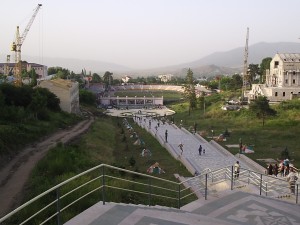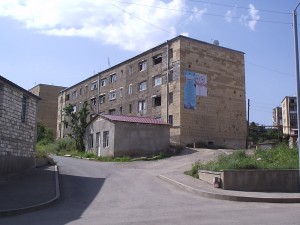Border – Nagorno Karabach 15 Years Later
Category: guests, movies
Tags: armenia, azerbaijan, Harutyun Khachatryan, nagorno karabach
Maria Nilsson has seen the movie Border by the Armenian director Harutyun Khachatryan.
In the beginning of February the award winning Armenian director Harutyun Khachatryans movie “Border” was shown on the Gothenburg Film festival. Border is set against the mountains of South Caucasus and the unresolved conflict between Armenia and Azerbaijan over the region of Nagorno Karabach in the south Caucasian mountains. This war stricken parts of the world has suffered greatly the last twenty years. In the centre of attention in this very slow and scarsly spoken movie is a small mountain village and its inhabitants. The camera is slowly capturing the change of season while the conflict is continuously present in the shape of barbed wire and sirens surpassing all other noises.
The conflict
The war in Nagorno Karabach was yet another war that broke out in the aftermath of the fall of the Soviet Union over territories that was close to impossible to pronounce for Western journalists. The war in Nagorno Karabach would however prove to be unusually bloody and drawn out. Between 1991 and 1994 over 35000 is believed to have been killed in the fighting’s and many times more were forced to leave their homes. The background of the conflict is found in historical antagonism, Stalin’s power play and the control vacuum opening after the dissolution of Soviet Union. Nagorno Karabach with an Armenian majority was 1921 by a direct decision from Stalin transferred from the Armenian SSR to the Azerbaijan SSK and consequently during the following years a large number of Azeris settled in the Nagorno Karabach area. During the highpoint of glasnost and perestroika the local parliament of Nagorno Karabach voted for the region to be transferred to the Armenian SSR which was highly opposed by Moscow, a resistance that was keep until the fall of the Soviet Union.
The independent Nagorno Karabach
Nagorno Karabach republic (NKR) or Mountainous Karabach as the area is also called, declared itself independent in 1994, the same year as the cease fire was brokered. Today the region is not recognized by any other state but still keeps its own parliament, president, currency the cease fire is still only a cease fire and retained by the several thousands of soldiers on both sides of the barb wires. Nagorno Karabach would not survive with out the economical, military and societal support from Armenia and the ties between the two are strong although combined with a sense of a distant and occasionally problematic and stubborn relative. The first decade of alleged independence have not been an easy path for Nagorno Karabach. Not unlike similar regions for example Transnistrien (Moldova), Adjarien (Georgia) the declared independence has brought with it a corrupt, sometimes straight out criminal, domestic politics.
Travelling in Nagorno Karabach means travelling through the landscape that H Khachatryans so precisely paints in the movie Border. The narrow road after turning left on the main road leading from Yerevan to Iran is ironically called a highway but could easily be taken for a village road. Climbing up the Caucasian mountains and further into the Nagorno Karabach area it is difficult to understand how two cars could ever meet. The incredible Caucasian mountain that has not only proven to be highly accommodating for beyond cruel guerrilla wars but also creates one of the most inaccessible areas in the region. The first impression of the landscape and reappearing in the movie is the lack of visible human lives and the breathtaking sights. Houses are randomly placed down the slopes of the mountains, coming closer it is visible that only a fraction of the houses are occupied while the majority of them still appears to have been left in a hurry under fire of hostile troops and often with snipers holes left on the house shells. Judging from the reconstruction process the cease fire could have taken place fifteen days ago, not fifteen years ago.
As in any war stricken society there are instances coming across as oddly out of place. In Nagorno Karabach it is the BMW cars trafficking the road in sharp contrast to the ladas and muscovite, the giant football stadium right in the centre of the city and the village Vank located a few miles outside of the main city Stepanakert. Vank contained as many others villages a mixed Armenian and Azeri population before the war but in the ethnical cleansing during the war all Azeris left the villages. A now Russian based oligarch was born in the village of Vank and has donated large sum of money to the reconstruction of the school which now must the only school in Nagorno Karabach with an adjoining swimming pool.
The slow moving film border capture both the harsh living conditions for the inhabitants left to the mercy and ever changing conditions of nature. It is cold, it is raw, it is tough and transfers a sense that the people are too preoccupied mere surviving to shed any time on unnecessary small talk. Ending with a devastating fire on the eve of a young couples wedding the movie communicate a message of hopelessness and resignation transcending from the unresolved conflict where the lack of permanent peace agreement is preventing financial and societal improvements. Until this can be accomplished the next fifteen years appear to be following the same track as the preceding fifteen.



Film stills from the movie Border.
You can also read a review of the movie Boarder at Kinokultura.





